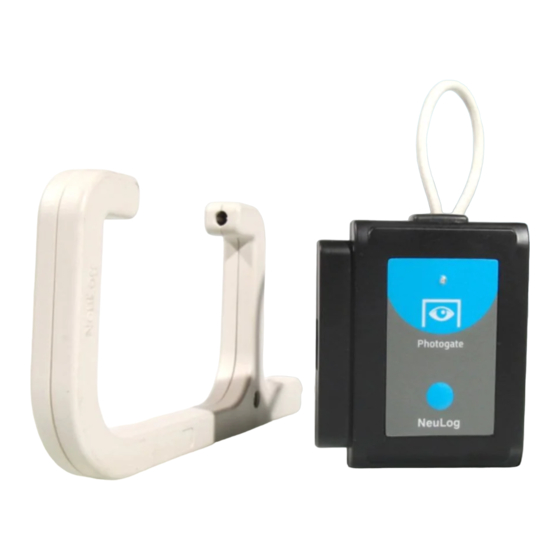
Table of Contents
Advertisement
Quick Links
NeuLog photo gate logger sensor
NUL-209
The NeuLog photo gate sensor can be used for any science experiment or
activity which involves taking accurate velocity and/or acceleration
measurements especially in the field of Physics.
The sensor comes pre-calibrated so you can start experimentation right out
of the box using any of the following guides.
Just a few of the thousands of possible experimental subjects that can be
done with the NUL-209 sensors are: velocity/acceleration/distance
relationships, impulse, collisions, conservation of energy, force,
momentum, and many more.
The photo gate sensor uses an infrared beam which detects if an object is
passing through it. Therefore the sensor actively reads out as "open" or
"blocked". While collecting data however there are several parameters to
truly customize your experiment:
Velocity with a single gate
NEULOG PHOTO GATE SENSOR GUIDE
Experiment customization:
The NeuLog photo gate sensor offers several different experimental
customization options. To access them; click on the "Experiment Setup"
button after your photo gate sensor has been detected. Note: Refer to the
guides below for more information on using NeuLog sensors
Timing cards:
Making timing cards is a unique option to further customize any experiment
with the NeuLog photo gate sensor. To make timing cards we recommend
cutting your desired shapes out of black plastic for the most accurate
readings though even plain paper will work just fine.
For example:
Velocity with a single gate:
Velocity with a single gate is the very basic velocity measurement using
only one photo gate sensor and any object with a known width.
Advertisement
Table of Contents

Summary of Contents for NeuLog NUL-209
- Page 1 The NeuLog photo gate sensor offers several different experimental customization options. To access them; click on the “Experiment Setup” The NeuLog photo gate sensor can be used for any science experiment or button after your photo gate sensor has been detected. Note: Refer to the...
- Page 2 Acceleration with two gates: Click the “Experiment Setup” button in the NeuLog software and Acceleration with two photo gates requires two Neulog photo gate sensors select “Velocity with two gates”. and an object or timing card with a known width.
- Page 3 USB-200 module then connects to a computer via a USB to mini-USB cable. Please note that you cannot plug the photo gate sensor directly into Change in time between two photo gates requires two Neulog photo gate the computer. sensors and an object or timing card with a known width.
- Page 4 WIFI-201 module will create a closed NeuLog wifi network which will the sensors, this can take a few minutes. stream the NeuLog data to a device of your choosing. Once your device is 11. If the browser does not auto detect, select “Search for sensors”...
- Page 5 NeuLog viewer). Select which experimental data to upload. (5 experimental runs can Materials needed: be stored at one time on the NUL-209 photo gate sensor) NUL-209 Photo Gate Sensor BAT-200 Battery Materials needed to configure your offline experiment: ...
- Page 6 Threaded rod for easy connection to retort stands or other labware. Technical background: The philosophy behind NeuLog’s plug and play technology is based on Sensor specifications each sensor’s ability to store its own data due to an internal flash memory...
- Page 7 The NeuLog photo gate sensor uses an infrared beam to determine when an object has passed through the photo gate. Every point that there is a break Flexible, simple, fast, forward thinking.
- Page 8 NEULOG PHOTO GATE SENSOR GUIDE...
















Need help?
Do you have a question about the NUL-209 and is the answer not in the manual?
Questions and answers